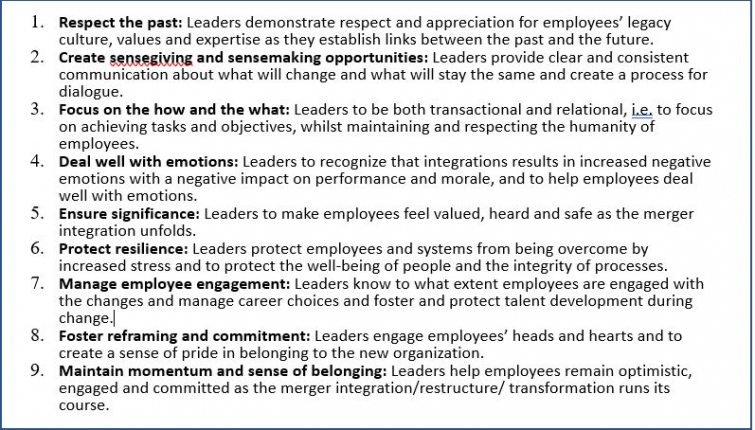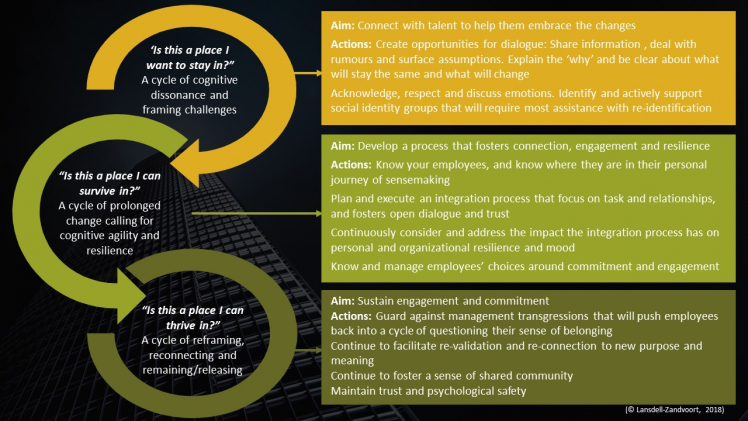19.04.2021
Lessons leaders can learn from those living through change
The number of merger and acquisitions (M&As) and subsequent organizational restructures and culture integration initiatives continue to increase year-on-year. Most leadership teams assume that their Human Resource (HR) departments will be able to support the management in delivering a successful integration strategy, often assuming the reliance on a project management approach planned and executed from the top-down. Sadly, despite a steady increase in merger activity, merger integration failure rates continue to increase exponentially (83 percent Forbes 2019) as projected synergies fail to materialise.
In a research study conducted by Ashridge Executive Education part of Hult International Business School, we opted for a different research lens by focussing our attention towards the recipients of a merger integration process instead of the C-Suite leaders responsible for the M&A decisions. The aim was to understand how the integration process was experienced and what lessons leaders can learn about executing the merger strategy while capturing hearts and minds if those living through change.
We identified nine themes merger integrations should focus on, as well as the relevant personal, inter-personal and public/organisational leadership skills needed to deliver expected merger outcomes and to avoid known pitfalls such as loss of talents, failure to deliver synergies, customers focus and projected performance results.
Lessons leaders can learn from those living through change:

These insights in themselves were not revolutionary nor unexpected, yet we have encountered countless organizations where employees state that their leaders are unable to deliver these basic ‘soft skills’ whilst executing a major change initiative. It seems that leaders need to develop the ability to consistently balance delivering both ‘hard’ and ‘soft’ elements of change management, throughout the life cycle of the change process, which in mergers can span over many years. Thus, this means developing leadership ability to pay equal attention to employee morale, engagement, emotions and resilience during the transformation as they do to organisational structures, systems, processes and key performance measures.
At an organizational level, in order to succeed in implementing the ‘hard factors’ of your transformation, you need to have a credible and sustainable process of focussing on addressing the ‘soft factors’ of change. This means your transformation process needs to be designed and executed with the journey of your employees foremost in your mind. To help you do this, our research suggest that employees undergo a process of responses to transformational change that is messy, and non-linear.
This means that your transformations cannot be implemented in a rigid and linear fashion. It does not however mean that you cannot plan the process. On the contrary, we suggest that you should plan your transformation implementation but that you should plan to accommodate the human experience of the transformation that is messy, emotional and personal to those who are asked to change.
To help you envisage this messy process, we propose a transformation process consisting of three cycles of human experience and sensemaking which can broadly be mapped onto any transformational initiative.
A three-step transformational process:

From an HR and Learning and Development (L&D) perspective, it means helping the individuals with a leadership and management role to become more conscious of their personal mindset and attitudes towards change, and towards the role of employees during change. It also transfers a responsibility to the organization to ensure that their leaders and managers are competent in leading change, for example, that they display the appropriate level of inter-personal skills and competencies to lead both hard and soft elements associated with major change initiatives.
Crucially, because major changes such as merger integrations are complex and involves the need to integrate and align wider systems, processes, agendas and stakeholders, leaders need to develop their public leadership skills. In particular, the ability to influence the wider systems and stakeholder environment in order to ensure a sustainably successful transformation.
It is often in this public leadership domain where most organizations struggle the most. For example, leaders feel unable to effectively shape the decision-making process to enable bottom-up dialogue and transparency, and employees (including HR) feel frustrated due to their inability to align existing processes or practices to the need created by the changing environment. Some of the most common public leadership challenges centres around the alignment of processes such as recruitment, on-boarding and exiting employees, job descriptions, performance management, and recognition and reward systems, in support of the overall strategic goals which precipitated the merger/change initiative.
To help organizations make sense of this complex task, we have developed ‘The Transformational Leadership Index’ a diagnostic tool developed around the personal, interpersonal and public leadership skills needed to deliver on each of the nine themes our research identified. Organizations who complete a two-level 180 degree assessment survey are provided with a report highlighting the areas of the transformation where employees and leaders are experiencing the biggest challenge, and can assist HR and L&D departments in developing a tailored intervention to support the successful merger integration and/or transformational change initiative they have embarked on.
For more information on the Transformation Leadership Index please contact psychometrics@ashridge.hult.edu or to obtain a copy of the full Hult Research Report please visit our website.
Dr Ilze Lansdell-Zandvoort
***Alkuperäinen teksti on julkaistu Ledelse i Udvikling -lehden numerossa 2-2020, jota julkaisee DANSK HR

